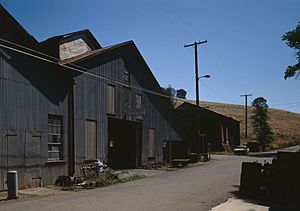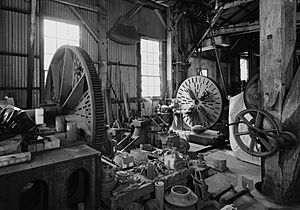Knight Foundry facts for kids
Quick facts for kids |
|
|
Knight's Foundry and Shops
|
|

The outside of Knight Foundry.
|
|
| Location | 81 Eureka Street, Sutter Creek, CA, 95685 |
|---|---|
| Built | 1873 |
| Architect | Samuel N. Knight |
| NRHP reference No. | 75000423 |
| Added to NRHP | July 1, 1975 |
Knight Foundry is a historic cast iron factory and machine shop in Sutter Creek, California. It was built in 1873 during the California Gold Rush. Its job was to make and fix heavy machines for gold miners and the timber industry.
The foundry's founder, Samuel N. Knight, invented a special kind of water turbine called the Knight Wheel. This wheel used the power of water to run machinery. It was an early version of the famous Pelton wheel. Knight's invention helped power some of the first hydroelectric plants in the American West. Today, Knight Foundry is the last water-powered foundry and machine shop in the United States. A large 42-inch (107 cm) Knight Wheel still powers the main equipment.
Contents
History of the Foundry
Samuel Knight's Inventions
Samuel Knight moved to California from Maine in 1863. He designed his Knight Wheel to be very powerful. It worked by shooting a high-pressure jet of water at a series of cups on the wheel. This spun the wheel and created energy. By the 1890s, Knight had made over 300 of these wheels. They were used all over the western United States.
Another inventor, Lester Allan Pelton, created a similar wheel in 1878. The Pelton Wheel had two cups side-by-side instead of one. In a competition in 1883, the Pelton Wheel proved to be more efficient. It soon became the most popular design. Even so, Knight continued to innovate. He invented an improved device called a governor that controlled the water flow for any type of water wheel.
A Gold Rush Business
During the Gold Rush, Knight Foundry was a busy place. It made important items like mining equipment. It even made street lights for the growing towns in the area.
After the Gold Rush ended, the foundry kept going. It specialized in making custom parts that couldn't be made in big factories. Knight also invented other machines. His shop held eight patents for its designs.
Changes in Ownership
Samuel Knight died in 1913. He left the foundry to his employees. It was owned by its workers until 1970. Then, it was bought by Carl Borgh, an aerospace engineer who was a customer.
The foundry operated until 1996 when Borgh retired. It became a museum for a short time. In 2000, Richard and Melissa Lyman bought the foundry to help preserve it. They hoped a non-profit group could raise money to buy it, but this didn't happen.
Finally, on December 31, 2016, the Lymans generously donated the land and buildings to the City of Sutter Creek.
How Things Were Made
The process of making metal parts at the foundry was fascinating.
- First, a woodworker made a model of the part out of hardwood. This model was called a pattern.
- The pattern was placed inside a special box called a casting flask.
- A special sand mixture was packed tightly around the pattern.
- The box was opened, and the wooden pattern was removed. This left a perfect impression, or mold, in the sand.
- The box was closed again, and workers poured melted, liquid iron into the mold through a small channel.
- Once the iron cooled and hardened, the sand mold was broken apart. This revealed the new, rough metal part.
The Foundry Today
Knight Foundry is a very important historical site. It is a California Historical Landmark and is on the National Register of Historic Places. The American Society of Mechanical Engineers (ASME) also named it a Mechanical Engineering Historic Site.
The foundry is now a "living museum." This means you can visit and see the old machines in action. The public can take self-guided tours on the second Saturday of every month. Private and school tours are also available. A non-profit group called the Knight Foundry Alliance helps take care of the site and runs the tours.




